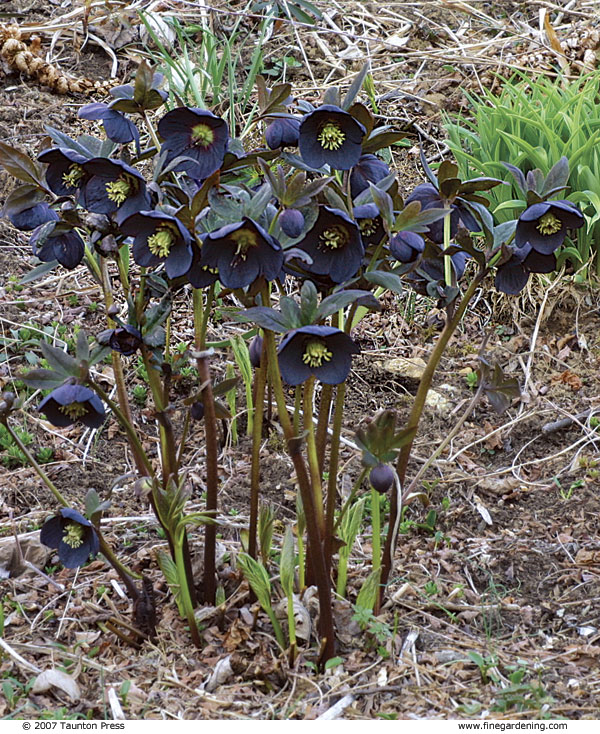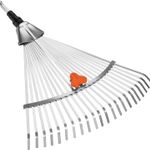
I enjoy a four-season garden, so I find it particularly rewarding to have blooms that start in late winter and early spring. This is when hellebores take center stage. Even when flattened by winter’s harsh frost and snow, they revive with the first warming rays of the sun. You simply have to love a plant that braves what nature throws at it and can still show off at this time of year. And those flowers last a long time—from March to May in my Pennsylvania garden. That they are great shade plants and basically evergreen only adds to their allure. The most popular and, for that matter, easiest to grow are the Oriental hybrid hellebores (Helleborus × hybridus cvs., USDA Hardiness Zones 6–9). Their common name is Lenten rose because they bloom around the beginning of Lent. And as long-blooming, low-maintenance, basically evergreen perennials that tolerate even dry shade and can flower before the snow melts, these plants have few equals in the garden.



With the dizzying array of choices available, it’s easy to find something you like. That said, some hellebores are better than others, and armed with a little knowledge, you can be sure to walk away from your local garden center with the pick of the litter.
To get what you want, buy it in bloom






Hellebores come in virtually any color you want: white, green, pink, apricot, and purple, to name just a few. We breeders haven’t created a worthy true blue or true red, but we’re working on it. My favorite colors for hellebores seem to change every year. Currently, I’m partial to the yellows and the blacks (which are really a shade of deep purple).
One isn’t limited, however, to this rainbow of solid colors. Hellebores can also have beautiful picotee edges (those that are a different color than the rest of the flower) or veining to adorn the outside of the bloom. Inside, they can have spotting or a dark center that draws your eye into the flower.
The varied offerings extend to the shape of the flowers as well. In addition to single, double, and star-shaped flowers, hellebores can have an anemone-flowered form, which looks like something between a single and a double.
When purchasing a hellebore, the best way to ensure you are getting what you want is to buy it in bloom. Look for colors that are unmuddied by too much green in the flower—unless they are green by design. If the flower is a picotee or is veined or spotted, the markings should be uniform on all petals (which are actually sepals).
Oriental hybrid hellebores
Helleborus × hybridus cvs.
(Hel-LEB-or-us ex HY-brid-us)
Zones
Hellebores are hardy in Zones 6 to 9.
Exposure
They tolerate almost full sun to almost full shade but prefer partial shade. Dense shade may reduce flower production.
Soil
Generally, they enjoy slightly neutral to acidic soils. Don’t plant them in a spot that’s too wet, as this encourages rot.
Planting depth
The crown should be just covered by the soil. As with peonies, planting hellebores too deeply inhibits flower production.
Care
They value a yearly application of well-rotted manure or compost to encourage strong growth but will forgive you if you forget for a year or two. To better view their flowers, remove the past year’s foliage in late January or early February before the buds emerge, to avoid damaging them. Don’t throw the old leaves in the compost heap because it takes more than a year for them to decompose.
Pests
They are largely untroubled by diseases or pests, including deer.
Propagation
They rapidly self-sow. You may want to discourage this tendency, not only to keep the garden tidy but also to prevent seeds from sowing themselves in the crowns of other plants. Don’t expect seedlings to be true to parent type. Although division isn’t necessary, it is the best method for creating an exact duplicate of a particular plant. In spring or late summer, simply pull the crown apart with your hands. Keep the plants sufficiently watered.
I like hellebores with a short stem or pedicel at the base of the flower, which causes the flower to face outward rather than down. If the flower dangles, I am not put off. I enjoy turning up their faces—participating with the plants, if you will.
If the hellebore you want to buy is not in bloom, you will have to make some detailed inquiries. Hellebore seedlings are unlikely to look like the plant they came from, unless the parent was specifically bred to produce such offspring. Better garden centers should be able to answer questions about the plant’s parentage and the likelihood that it may be true to type.
I usually don’t recommend searching for named varieties of hellebores because there aren’t many around, and with a keen eye, you can find an unnamed plant that is equal to the one you are looking for. A hellebore is often listed as belonging to a specific strain or line (Royal Heritage Strain or Pine Knot Strain, for example) that is bred for a specific purpose, be it color saturation, color variety, or flower shape. It is a good practice to inquire about the attributes for which your intended purchase was bred.
I consider hellebores nature’s gift in winter. They are the perfect cure for long winters and cabin fever, heralding spring even before the daffodils.
More hellebores to consider
Click on the links below for photos and cultural requirements of these outstanding hellebores:
Helleborus odoratus ‘Double Queen’
Fine Gardening Recommended Products

Razor-Back Potato/Refuse Hook
Fine Gardening receives a commission for items purchased through links on this site, including Amazon Associates and other affiliate advertising programs.

Ho-Mi Digger - Korean Triangle Blade
Fine Gardening receives a commission for items purchased through links on this site, including Amazon Associates and other affiliate advertising programs.

Gardena 3103 Combisystem 12-Inch To 20-Inch Adjustable Metal Fan Rake Head
Fine Gardening receives a commission for items purchased through links on this site, including Amazon Associates and other affiliate advertising programs.


















Comments
Kind of hard to see things under 60 inches of snow
LOL! You must be in the Upper Midwest! My son reports almost 5' of snow in Northern WI (where I will NOT be going until after it melts, thank you very much!) It's 5F here in Central IL - but at least the snow is gone.
An offspring of one of my plants ( MA Zone 6) bloomed in October with a somewhat different curled bloom. I will be watching this one to see if it also blooms this spring or if it again blooms in the fall, or both .
I live in Zone 3b. Looking at catalogs and websites, I see many Hellebores are hardy to Zone 4 and few to Zone 3. I'm not sure why the author indicates only Zones 6-9.
Log in or create an account to post a comment.
Sign up Log in